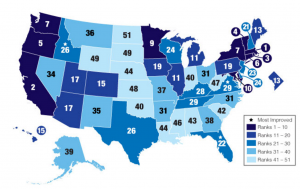 Give yourselves a pat on the back for Virginia earning the title of “Most Improved” in ACEEE’s 2017 State Energy Efficiency Scorecard.
Give yourselves a pat on the back for Virginia earning the title of “Most Improved” in ACEEE’s 2017 State Energy Efficiency Scorecard.
Tied for 29th place means there is still plenty of room for advancement, but what we’re doing is working!
The Commonwealth joined Florida and Idaho in receiving the “Most Improved” honor, which underscores the work VAEEC members and our partners have done to advance smart energy efficiency policies and initiatives while also calling out some specific steps we could take to break into the top 25.
We moved up from 33rd place in last year’s ranking (which we wrote about here) and scored 15.5 points out of a possible 50, so maybe keep the corks in the champagne bottles for now.
Governor Terry McAuliffe had this to say: “I am encouraged that ACEEE continues to recognize the excellent work we are doing in the Commonwealth to advance energy efficiency through innovative programs such as the VASaves Green Communities Program and Energy Performance Contracting for public agencies. While we have made progress in these areas, there is still much to be done to grow utility-sponsored programs and encourage strategies like Combined Heat and Power. Energy efficiency is a win-win for Virginia’s economy and our environment, and we must build on the momentum generated over the last four years.”
VAEEC was pleased to see several of our policy recommendations from our recent “Why Energy Efficiency is a Smart Investment for Virginia” census report — like stronger utility programs and continued energy performance contracting — were called out in the Scorecard.
Here is an excerpt:
However the state has significant room to strengthen efficiency programs and policies in the utility sector. To guarantee energy and cost savings for businesses and residents, the state could make its 10% electricity savings target mandatory and offer performance incentives to utilities achieving higher levels of electricity and natural gas savings. Virginia could also work to streamline the process by which utilities evaluate, measure, and verify energy savings which may help utilities to develop efficiency programs with more comprehensive measures. To keep costs low for all Virginia consumers, utilities could design programs that better meet the needs of large customers.
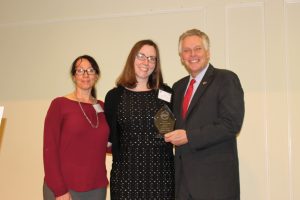
In addition, the one example ACEEE cited on the Virginia scoresheet was Columbia Gas winning one of VAEEC’s Virginia Energy Efficiency Leadership Awards for their WarmWise online home energy audit.
Bottom line is that we’re making progress, but we need more investments in and support for the programs and policies that bring that type of robust energy savings. VAEEC laid out 5 specific, tangible, realizable policy priorities in our recent census report that we believe would help Virginia bust into ACEEE’s top 25 and keep rising.
Download the report or check out the Virginia scoresheet.
It’s been a while since our last blog post on the building codes update process and a lot has happened since then. In April, VAEEC and several of our members, participated in an energy stakeholder group to reach consensus with the homebuilders and code officials to incorporate some energy efficiency measures in the new draft Uniform Statewide Building Code (USBC).
These new energy efficiency requirements include removing the visual inspection for duct-testing and bringing duct-testing standards up to the current 2015 model code standard. According to a Department of Energy report, requiring mechanical testing for both air-duct tightness and building envelope tightness are significant opportunities for Virginia. According to the EPA, leaky ducts can reduce the performance efficiency of heating and cooling units by 20%. We are very pleased to see the inclusion of mechanical testing for duct leakage in the new USBC.
 A second component of the energy subgroup compromise proposal, includes adoption of the 2018 model code Energy Rating Index (ERI) compliance option rather than the 2015 version. This newer version gives homebuilders greater flexibility and trade-off options, which is important since homebuilders in states that have already adopted the 2015 model code, have been slow to use this pathway. By implementing the 2018 version, Virginia is making the ERI pathway more enticing, which will hopefully result in greater participation.
A second component of the energy subgroup compromise proposal, includes adoption of the 2018 model code Energy Rating Index (ERI) compliance option rather than the 2015 version. This newer version gives homebuilders greater flexibility and trade-off options, which is important since homebuilders in states that have already adopted the 2015 model code, have been slow to use this pathway. By implementing the 2018 version, Virginia is making the ERI pathway more enticing, which will hopefully result in greater participation.
The compromise proposal unanimously passed the Codes and Standards Committee of the Board of Housing and Community Development last month. This new proposal will be part of the new draft USBC that will be reviewed by the full board on October 16, 2017.
You can read more about our support for these proposals in our letter to the Department of Housing and Community Development (DHCD) during the public comment period earlier this year.
These new components are in addition to the energy efficiency measures that are already included in the draft USBC, which was published last December in the Virginia Register. These proposals include improvements on lighting requirements, hot water pipe insulation, and the creation of the 2015 ERI compliance option.
So where do we go from here?
According to the DHCD website, the timeline below lists the next steps to finalizing the new regulations:
- October 16, 2017: DHCD Board will review and vote on final USBC; final draft will be sent to the Governor’s office for review
- Late Fall 2017: Governor’s office and Office of the Attorney General review final draft
- December 2017/ January 2018: Final regulations printed in Virginia Register and 30 day comment period
- February/March 2018: New regulations take effect
Even though we have made good strides in advancing energy efficiency through the building codes, there is still more work to be done. VAEEC will continue to advocate for more efficient window and insulation requirements in future USBC updates, as well as mandating mechanical testing for building envelope air-tightness. Proper air-tightness helps consumers save money on their energy bills while maintaining a consistent comfort level throughout the home by reducing the potential for air leakage to the outside.
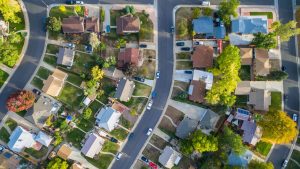 VAEEC partnered with one of our members, Responsible Energy Codes Alliance, to submit a proposal to DHCD staff to host a stakeholder group to review these issues next year, in the hopes that a compromise can be reached on inclusion of this crucial energy efficiency practice in the next USBC update. Last month, we were pleased to see the full DHCD board unanimously vote to support these efforts.
VAEEC partnered with one of our members, Responsible Energy Codes Alliance, to submit a proposal to DHCD staff to host a stakeholder group to review these issues next year, in the hopes that a compromise can be reached on inclusion of this crucial energy efficiency practice in the next USBC update. Last month, we were pleased to see the full DHCD board unanimously vote to support these efforts.
This workgroup will review the results from the DOE Field Study being conducted by VAEEC members Viridiant and the Southeast Energy Efficiency Alliance (SEEA) who will be collecting data in the field to determine what, if any, compliance issues could be addressed through training and education. You can read more about this study on SEEA’s website. The results of this study will greatly inform the workgroup’s ongoing discussions on the need to require mechanical testing for whole-home air tightness. The VAEEC is also working with other members to potentially host a training for the stakeholder group to demonstrate the tests themselves and how the results are interpreted.
You can read more about our recommendations for future building code updates here.
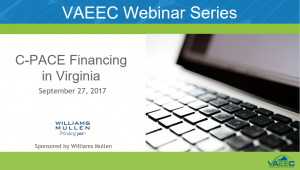 By now, many of you have probably heard us speak about commercial Property Assessed Clean Energy, or PACE, financing. It has become one of VAEEC’s top focuses in the past few years due to its ability to spur economic growth and revitalization while also reducing energy usage in commercial buildings. To learn more about the basics of PACE, visit our PACE webpage.
By now, many of you have probably heard us speak about commercial Property Assessed Clean Energy, or PACE, financing. It has become one of VAEEC’s top focuses in the past few years due to its ability to spur economic growth and revitalization while also reducing energy usage in commercial buildings. To learn more about the basics of PACE, visit our PACE webpage.
Recently, VAEEC held our second PACE webinar, C-PACE Financing in Virginia, back in September. Unlike our first PACE webinar, which mainly covered the basics of PACE, the main goal of this webinar was to be a resource for localities interested in developing and implementing a PACE program. The webinar provided listeners with:
- A brief overview of C-PACE, including its legality and case studies,
- Best practices when developing and implementing a program,
- The program administrator’s role,
- The benefits to localities, and
- The internal process of developing a PACE program.

PACE provides financing for energy efficiency renovations for commercial and multifamily buildings.
William Nusbaum (Williams Mullen) kicked things off with an overview of what PACE is and how it works in Virginia. He also touched on the Mid-Atlantic PACE Alliance, or MAPA, which is a partnership between Virginia, Maryland, and DC stakeholders created to accelerate PACE programs and project closings in the region.
Time and resources are by far the two most common concerns we hear from localities when talking about developing a PACE program. Scott Dicke (Sustainable Real Estate Solutions (SRS) and Arlington C-PACE) was able to address these concerns by discussing the role of the PACE program administrator. Program administrators alleviate the burdens placed on a locality when starting up and running a PACE program. They provide contractor education and support services to contractors, building owners, capital providers, and localities. Scott reinforced these points by providing case studies of programs SRS has helped launch and run.
Susan Elliott (City of Charlottesville) closed out the webinar with a local government perspective. Localities are interested in PACE because it is a tool that helps spur economic develop and revitalize existing building stock. Furthermore, Susan dove into the internal process of developing a PACE program and spoke about existing resources that help localities each step of the way.
Presentation slides and the audio recording can be accessed here. If you have any questions or if you would like additional information about PACE, please contact Jessica Greene.
A special thank you to Williams Mullen, our webinar sponsor, and our speakers.
When we released out latest Virginia Energy Efficiency Industry Census report this spring, we found that revenue generated from the energy efficiency sector has grown from nearly $300 million in 2013 to $1.5 billion in 2016. And we noted U.S. Department of Energy stats that the industry is responsible for 75,000 jobs across the state. Indeed, it is a huge part of the new Virginia economy.
But it raises an important question. Just what kind of jobs count as “energy efficiency jobs”?
 From architects and contractors designing, building, and renovating more efficient buildings, energy auditors testing a building’s performance, HVAC contractors installing high-performance systems, to energy managers for cities and counties trying to find ways to save their residents money, and weatherization providers helping low-income residents save money on their own energy bills, and to those working to shape public policy or develop software to monitor energy use, the list goes on.
From architects and contractors designing, building, and renovating more efficient buildings, energy auditors testing a building’s performance, HVAC contractors installing high-performance systems, to energy managers for cities and counties trying to find ways to save their residents money, and weatherization providers helping low-income residents save money on their own energy bills, and to those working to shape public policy or develop software to monitor energy use, the list goes on.
Here are 5 examples of energy efficiency jobs:
1. Sustainability Directors
At the county or city level of government, this position is in charge of ensuring that a local government is meeting its goals for sustainability and energy use. Efficient use of energy is the first step in becoming environmentally friendly, and as local governments work towards their goals of sustainability, energy efficiency is a high priority. Monitoring energy use, educating employees on their usage, as well as ensuring government-owned buildings meet efficient standards are all a part of a Sustainability Director’s job.
As if being tasked to track and monitor government energy usage isn’t a handful already, here’s just taste of the laundry list of responsibilities a sustainability director undertakes: coordinate city or county wide strategies that promote sustainable and green practices; identify methods and policies (typically through benchmarking); work with community groups to integrate green design into their projects; increase the use of energy efficient products and engineering; develop and implement the systems to track and monitor efforts across City departments; serve as an outreach coordinator to build strong relationships with partner organizations and field experts; and develop education materials for contractors and homeowners. The list goes on in this vital job to successfully implement energy efficiency policies at the local level.
Note that the exact job title varies. The person responsible for overseeing this work might, using VAEEC member City of Charlottesville as an example, be the City’s Environmental Administrator or up in Arlington they have an Energy Manager.
2. Energy Service Companies
An energy service company or ESCO provides a broad range of energy solutions including the design and implementation of energy savings projects, retrofitting, energy conservation, energy infrastructure outsourcing, power generation and energy supply, and risk management. VAEEC members like Johnson Controls, Siemens, Southland and Trane have helped entities like grammar schools, universities and state government facilities like the Department of Motor Vehicles and Department of Corrections to upgrade their facilities and save taxpayer money.
Expanding the performance-based contracting that ESCOs offer was one of VAEEC’s five policy recommendations in our recent “Why Energy Efficiency is a Smart Investment for Virginia” report.
3. Software and Monitoring
As we live in a world increasingly connected through the internet and our devices, our energy use corresponds to our increasing reliance on technology. In turn, our energy use can be monitored through the internet and innovative software. Customer engagement and interactive applications allow energy consumers to monitor their energy usage from any device. The concept is simple: if you know how much you’re using then you know where to cut back. However, the monitoring required to provide customers with this information and the comparisons of what’s “good usage” vs “bad usage” are complex.
VAEEC member Oracle is one company that provides this information in an easy to use format. Taking the best of their paper Home Energy Reports, they format is to fit an easy to use and easy to engage system that emails customers directly about their energy usage. Customers using Oracle’s services can save up to 3% annually from this kind of direct engagement and awareness of their energy usage. Not only that but the Cloud services that Oracle provides allows people to store energy data, track it and compare it from a massive database of energy information.
4. Weatherization Providers
Weatherization projects allow homes to better withstand the elements, keeping interiors cool in the summer and warm in the winter. Instead of relying heavily on heating and cooling systems which expend energy, weatherization offers a more permanent solution through durable projects such as double paned windows, and insulating walls and attics. Homes are often neglected when it comes to weatherization, and this is especially true of low income families who have to prioritize their budgets. Low-income families often wind up spending a large portion of their monthly income on energy bills, and while weatherization alleviate energy costs the upfront expense can be daunting.
Project:Homes, a VAEEC member, offers services such as air sealing, insulation, LED lightbulbs and water savers to help low-income families make their homes more efficient. This not only increases property value, but makes the homes more comfortable to live in and saves homeowners and renters money on energy bills. Other Project:Homes initiatives such as “Keep It Cool RVA!” have helped provide window units and AC to those in need during the hottest months.
5. Contractors, Homebuilders + Technicians
You’re looking for a new house with energy efficient features or want to do a remodel with energy savings and sustainability in mind? There’s a contractor for that. Is it time to replace your HVAC system or just need a service heading into winter (or summer)? There’s a HVAC technician for that. Need some work or cleaning of your ducts to improve efficiency and indoor air quality? Yup, companies specialize in that. These jobs indirectly and directly qualify as “energy efficiency jobs.”
These are just some of the wide ranging jobs — white and blue collar — within the field of energy efficiency, each playing an important role in changing the landscape of how we think about and use energy.
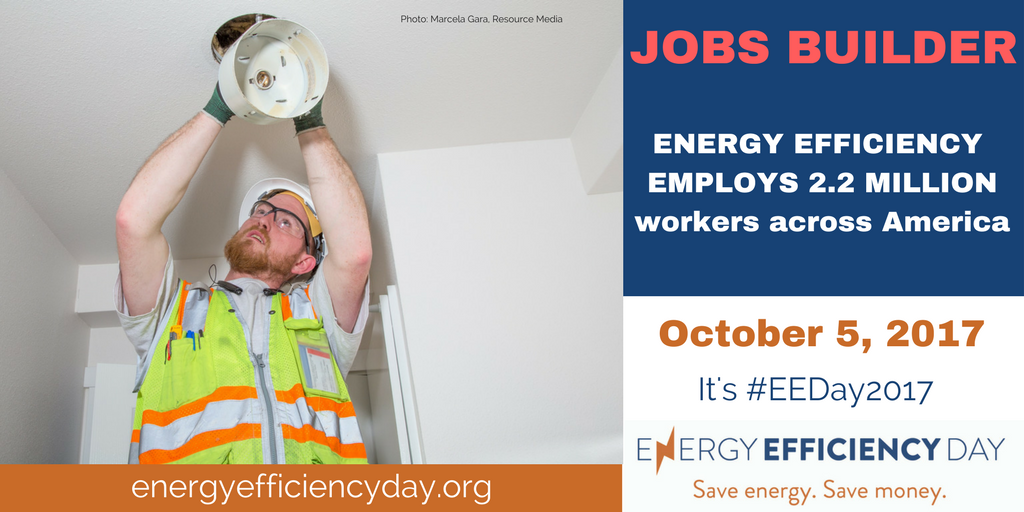
This Thursday is National Energy Efficiency Day #EEDay2017, a great time to recognize and celebrate everyone working in the energy efficiency field — and all of the jobs we sustain here in Virginia and nationwide.
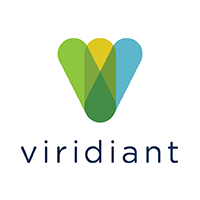 The U.S. Department of Energy (DOE) has been conducting field studies in select states around the country to determine the level of compliance with energy codes in the field. Recently, Viridiant, a VAEEC member, was awarded funding by the Southeast Energy Efficiency Alliance (SEEA) to conduct the study in Virginia.
The U.S. Department of Energy (DOE) has been conducting field studies in select states around the country to determine the level of compliance with energy codes in the field. Recently, Viridiant, a VAEEC member, was awarded funding by the Southeast Energy Efficiency Alliance (SEEA) to conduct the study in Virginia.
This project will look at how well a random sample of builders in 29 jurisdictions around the Commonwealth are implementing different energy related measures of the building code. The success of this project will largely rest on the cooperation of builders and building code officials.
Help spread the word that this study will be underway through the end of 2017, with data collectors visiting over 100 homes that are under construction or recently completed!
Energy efficiency programs are on the Congressional chopping block.
The House of Representatives will vote in the coming days on spending cuts to several of the Department of Energy’s energy efficiency programs such as ENERGY STAR and the Weatherization Assistance Program. The House Appropriations Committee advanced the cuts earlier this month, adding them to the docket for a vote. The cuts, if passed would be applied to fiscal year 2018.
Merged with a larger budget bill, the cuts would slash funding for several Office of Energy Efficiency & Renewable Energy programs by more than half. If passed the office would see funding fall from $2.1 billion to $1.1 billion. The current administration has proposed numerous cuts to energy efficiency programs over the last six months, including eliminating the highly successful ENERGY STAR program. While no programs have specifically been called out for elimination in the House bill, the severe cuts will force the DOE to evaluate spending, which could include the elimination of entire programs.
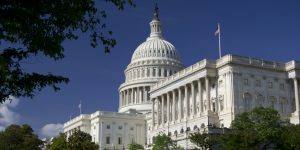 While the proposed spending cuts in the House are massive, the Senate Appropriations Committee advanced its Energy and Water Development appropriations bill on July 20, maintaining the current level of funding for energy efficiency programs.
While the proposed spending cuts in the House are massive, the Senate Appropriations Committee advanced its Energy and Water Development appropriations bill on July 20, maintaining the current level of funding for energy efficiency programs.
The House and Senate may disagree on the total amount for energy efficient spending, however both are an improvement from the initial proposals put forth by the current administration earlier this summer which would have gutted federal energy efficiency budgets. While wholesale elimination in FY18 is off the table for now, federal energy efficiency initiatives still face the prospect of unprecedented spending cuts.
It’s unclear whether or not the Senate Energy and Water Development appropriations bill will be voted on before the August break, due to prioritization of the repeal of the Affordable Care Act. Successful energy efficiency programs bring both economic and environmental benefits, producing jobs and savings. Promotion of these programs has historically been bipartisan and their continuation is important for the U.S. to remain competitive in the energy industry.
The agricultural industry consumes massive amounts of energy. In 2015 alone, farmers paid 10 billion dollars collectively in energy bills. Agricultural facilities expend energy in refrigeration and materials handling, pumping and heating, lighting, and fans.
In mid-June, VAEEC hosted a webinar with presenters Josh Ludgate from Energy Exact Inc. and Erin Puryear from Old Dominion Electric Cooperative. In 2012, Old Dominion Electric Cooperative and its nine Virginia distribution electric cooperatives, collaborated with the state energy office, Exact Energy, James Madison University, US Dept of Agriculture Natural Resources Conservation Service, USDA-Rural Development, and Virginia Dept of Agriculture and Consumer Services to develop a plan for offering information, education, and opportunities in energy efficiency for the agricultural sector. During the webinar, Josh and Erin share what this plan has entailed, the challenges and successes, and how they plan to move forward.
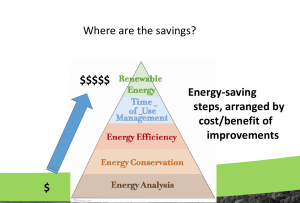 Erin introduced the Energy-saving steps, arranged by cost/benefit improvement pyramid. The base of the pyramid is Energy Analysis:
Erin introduced the Energy-saving steps, arranged by cost/benefit improvement pyramid. The base of the pyramid is Energy Analysis:
- Energy analysis must be made to identify costs and find opportunities where energy use can be reduced. Erin explained that after the energy analysis is made, agricultural facilities can achieve their cost/benefits achievement goals through the following:
- Energy conservation is the most cost beneficial approach an agricultural facility can take. It involves finding behavioral changes that can be implemented to increase energy saving.
- Energy efficient equipment is the next most cost beneficial approach an agricultural facility can take and includes fans, pumps or lights.
- Time of use management is the third most cost effective approach and includes using energy at an off peak hour to save money and electricity.
- Lastly, using Renewable energy, such as solar power, wind power, hydropower, biofuels, is helpful but it is the least cost beneficial.
Erin also discussed funding options, such as grants and loans through the USDA and education and awareness initiatives held in rural Virginia.
After Erin’s presentation, Josh with Exact Energy, reviewed a case study for poultry breeders and growers. Many growers had expressed skepticism to try energy savings technologies because of the perceived risk of high bird mortality. Growers were concerned the new bulbs would confuse the birds and affect yields. Typically, growers use either 100 W incandescent or CFL bulbs or 150 W High Pressure Sodium lamps. In this case study, energy monitoring systems and 23 W compact fluorescent bulbs and LED bulbs were installed in three houses to test several flocks. The lighting electrical consumption dropped by 80% and the average savings of the three houses was $522.99. Growers were overly pleased with the equipment installed, and the case study found that though there is room for advancements, there were no increases or decreases in bird production after implementing the recommendations.
In a state with over 6,000 poultry farms, there is a huge potential to access cost and energy savings for the agricultural sector.
For more information, view the entire presentation or listen to the audio recording.
VAEEC Supports New Efficiency Programs Proposed by Dominion Energy:
This past spring 2017, the State Corporation Commission heard oral arguments in support of energy efficiency programs, which were part of Dominion Energy’s 2016 Demand-Side Management (DSM) filing (Case Number PUE-2016-00111).
As part of this filing, two new energy efficiency programs (Phase VI programs) were proposed to replace Phase II programs, which expired last month:
- Residential Home Energy Assessment Program- bundled a home energy audit with direct install measures such as LED light bulbs, weatherstripping, heat pump tune-ups and adding hot water pipe insulation
- Non-Residential Prescriptive Program- incentive program for non-residential customers who do not qualify for other Dominion energy efficiency programs; includes installing ENERGY Star appliances, HVAC tune-up and commercial duct sealing and testing
The VAEEC formally intervened in support of the proposed programs during the proceedings this past spring. Our members recognize the incredible value that cost-effective energy efficiency programs provide to our local communities and all ratepayers within the utility’s service territory. We also bring a unique perspective to the conversation, representing our members who work in the field implementing these programs. During the two-day hearing, our attorneys with the UVA Environmental and Regulatory Law Clinic argued for the Commission to consider the economic benefits these programs provide to the communities they serve. According to Virginia code, it is unquestionably within the Commission’s discretion to consider these economic development benefits among the “other factors” evaluated, in addition to the cost-effectiveness tests. The Attorney General’s office rendered an opinion on this in their closing statements agreeing with our assessment. Our closing arguments go into further detail, which you can read here.
Unfortunately, earlier this month, the Commission denied the Residential Home Energy Assessment Program and approved the Non-Residential Prescriptive Program at half of the requested budget.
Dominion Energy had also requested a two-year extension for their Residential Heat Pump Upgrade Program through May 2019, which was also denied despite the fact that the utility was not seeking additional funding for this program.
In their ruling, the Commission based their decision entirely on the cost-effectiveness scores of these programs. This ruling was surprising for a number of reasons but especially since both of these programs had previously been approved by the Commission and this was not the recommendation from Commission staff. The staff had concerns about the programs but they did not recommend rejecting them outright.
It was also evident that they did not take into consideration our arguments that the economic benefits these programs create should be considered in addition to the cost-effectiveness tests.
So, what’s next? Right now, the Commission is soliciting feedback on how to establish protocols for Evaluating, Measuring and Verifying (EM&V) energy efficiency programs and the savings associated with them. The Commission decided to establish these much-needed protocols after receiving feedback from a variety of stakeholders last year, including the VAEEC.
As stated in our new report, “Why Energy Efficiency is a Smart Investment for Virginia”:
Establishing EM&V protocols for Virginia utilities will enable them to develop energy efficiency programs with a strong, data-driven foundation from which to expand their offerings to customers. Robust protocols assure that customers receive the benefits that energy-efficiency programs are designed to deliver.
We will continue to keep our members apprised of important regulatory issues as they arise.
Johnson Controls is a big name in energy efficiency and sustainabillity – with more than 120,000 employees serving a range of customers in more than 150 countries. And the company – VAEEC Business Gold member and June’s Featured Member of the Month — is having a big impact across the Commonwealth.
The company creates intelligent buildings, efficient energy solutions, integrated infrastructure and next generation transportation systems that work seamlessly together to deliver on the promise of smart cities and communities. At its core, that promise is about delivering innovation that make people’s lives – and the world – better.
 One area of focus is K-12 schools where Johnson Controls provides the building systems, equipment, technology integration and know-how to create and maintain safe & secure, quality learning environments. Plus they work with clients to identify innovative financing solutions to make these facility improvements with minimum impact on operating budgets.
One area of focus is K-12 schools where Johnson Controls provides the building systems, equipment, technology integration and know-how to create and maintain safe & secure, quality learning environments. Plus they work with clients to identify innovative financing solutions to make these facility improvements with minimum impact on operating budgets.
This doesn’t just make financial sense. Students who are comfortable and happy in their physical environments actually have a better chance of doing well in school. In fact, reports show that students in well-maintained facilities score up to 10 percent higher on standardized tests.
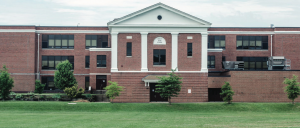 That was the concern in Luray, Virginia, where the Page County Public Schools struggled to provide comfortable classrooms on hot early and late summer days – particularly in many unconditioned second- and third-floor classrooms. Yet installing a new HVAC system had not be possible financially. At least not as a traditional, stand-alone purchase.
That was the concern in Luray, Virginia, where the Page County Public Schools struggled to provide comfortable classrooms on hot early and late summer days – particularly in many unconditioned second- and third-floor classrooms. Yet installing a new HVAC system had not be possible financially. At least not as a traditional, stand-alone purchase.
The local Johnson Controls team developed a plan to fund the improvements through an energy savings performance contract. Under the contract, Johnson Controls guaranteed that, by making a series of upgrades to lighting and building controls across the district, Page County Public Schools would generate enough operational and utility savings to pay for upgrades and offset the cost of air conditioning the un-cooled classrooms.
“The guaranteed savings of an EPC is a great way to fund facility improvements, especially when budgets are tight. In many cases, it’s the only way these kinds of projects can get done.” – Whit Blake, Johnson Controls
 The $7.5M project is guaranteed to save Page County Public Schools $10.2 million over 15 years, and included:
The $7.5M project is guaranteed to save Page County Public Schools $10.2 million over 15 years, and included:
- A full LED lighting retrofit across eight district schools, guaranteed to save the district $193,000 annually
- Metasys® Building Automation Systems installed to control and monitor critical energy systems, saving the district $149,585 annually
- New HVAC systems to condition the air in previously un-cooled classrooms
- Replacement of outdated boiler and rooftop units
In addition to helping Page County Public Schools stretch taxpayer dollars and create more comfortable learning environments, the project itself has created a new learning opportunity.
Through a web-based energy dashboard, students, teachers and Luray residents can access real-time information about the energy use and energy savings across the district, and the environmental impact on their community.
Read the full case study here.
VAEEC members earn points and show support for the Paris Climate Agreement
The American Council for an Energy Efficient Economy (ACEEE) released its annual report evaluating and ranking America’s largest cities for their energy efficiency. The City Energy Efficiency Scorecard is based on policy and program efforts and includes recommendations for improvement. The scores are given for five categories: local government operations, community-wide initiatives, buildings policies, energy and water utilities, and transportation.
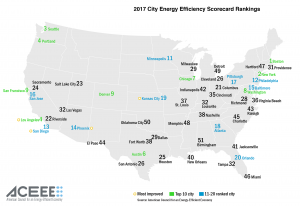
ACEEE ranked energy efficiency in America’s largest cities.
Virginia and its localities demonstrate a commitment to leading energy efficiency and climate change policy. In the wake of President Trump’s decision to withdraw the U.S. from the Paris Climate Agreement, Virginia has declared that it will continue efforts to mitigate climate change.
On June 5th, Governor Terry McAuliffe joined the U.S. Climate Alliance, a group of states in solidarity to uphold the goals of the Paris accord.
“As the first state in the Trump era to take executive action to limit carbon emissions and create clean energy jobs, Virginia is proud to join this alliance of states, cities and businesses. President Trump’s announcement to withdraw the United States from the Paris Climate Agreement does not speak for the states and cities that are committed to fighting climate change and paving the way for a new energy economy. If the federal government insists on abdicating leadership on this issue, it will be up to the American people to step forward — and in Virginia, we are doing just that.” –Gov. McAuliffe
In addition to support at the state level, as of June 3, 2017, more than two hundred mayors of U.S. cities have indicated support for the objectives of the alliance. Among them are VAEEC members Alexandria, Richmond, Charlottesville and Arlington County.

Virginia leaders from both the public and private sectors are joining forces to fight climate change and uphold the Paris accord.
These locations, as well as Virginia businesses, Randolph College and the University of Richmond (another VAEEC member), have signed the “We Are Still In” agreement.
Among the 51 cities ranked in the ACEEE scorecard, Richmond and Virginia Beach ranked 28th and 36th respectively. In addition, Richmond was one of three cities to earn a perfect score for municipal energy efficiency-related goals. The Scorecard and rankings act as a marker for progress and encourages cities to further energy efficiency efforts.
Arlington County and Charlottesville were also listed on the Scorecard website as unranked cities. They used the ACEEE criteria to create a self-score equivalent to the Scorecard’s ratings and were highlighted for their efforts and commitment to energy efficiency.
All four of the Virginia locations listed are VAEEC members. In fact, ACEEE awarded points for VAEEC membership. In their view, as an advocate for higher energy standards, membership with the VAEEC reflects a commitment to improving efficiency.
Here’s the breakdown of each city’s ACEEE score.
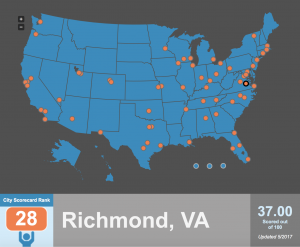 Virginia’s capital scored 37.00 out of 100 possible points. Richmond earned high marks in the local government category, outlining numerous policies for energy goals and strategies to reduce usage. One of the more ambitious goals began in 2014 with the RVAgreen Annual Progress Report. A goal was set to reduce the government greenhouse gas emissions by 80% by 2050 using 2008 as a baseline. Though this is a significant reduction rate, the ACEEE says Richmond is on track to achieving its goal. The report centered its recommendations for improvements in the energy and utility category, as well as transportation.
Virginia’s capital scored 37.00 out of 100 possible points. Richmond earned high marks in the local government category, outlining numerous policies for energy goals and strategies to reduce usage. One of the more ambitious goals began in 2014 with the RVAgreen Annual Progress Report. A goal was set to reduce the government greenhouse gas emissions by 80% by 2050 using 2008 as a baseline. Though this is a significant reduction rate, the ACEEE says Richmond is on track to achieving its goal. The report centered its recommendations for improvements in the energy and utility category, as well as transportation.
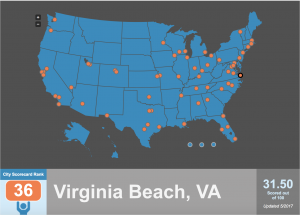 Virginia Beach scored 31.50 out of 100 possible points. Scoring similarly to Richmond, Virginia Beach was recognized for its Sustainability Plan which outlines some of the energy-efficiency related policies for its government operations. Virginia Beach also benchmarks 100% of local government buildings in ENERGY STAR Portfolio Manager. In addition, Virginia Beach has several community-wide initiatives, including the adoption of an urban heat island mitigation goal to achieve 45% urban tree canopy cover citywide by 2023. Like Richmond, Virginia Beach’s opportunities for improvement were in energy and utilities, and transportation.
Virginia Beach scored 31.50 out of 100 possible points. Scoring similarly to Richmond, Virginia Beach was recognized for its Sustainability Plan which outlines some of the energy-efficiency related policies for its government operations. Virginia Beach also benchmarks 100% of local government buildings in ENERGY STAR Portfolio Manager. In addition, Virginia Beach has several community-wide initiatives, including the adoption of an urban heat island mitigation goal to achieve 45% urban tree canopy cover citywide by 2023. Like Richmond, Virginia Beach’s opportunities for improvement were in energy and utilities, and transportation.
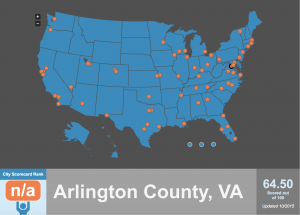 Though Arlington was not officially scored, the self-score generated was 64.50 out of 100 points. This places Arlington on par with some of America’s largest, most energy efficient cities. The county has outlined comprehensive strategies to reduce energy consumption and the Arlington Initiative to Rethink Energy oversees the implementation of these policies. Arlington also scores impressively in both building policies and transportation, with a Master Transportation Plan that aims to promote more pedestrian and bicycle transit. Though scoring high in most categories, room to grow can be found most in energy and utilities.
Though Arlington was not officially scored, the self-score generated was 64.50 out of 100 points. This places Arlington on par with some of America’s largest, most energy efficient cities. The county has outlined comprehensive strategies to reduce energy consumption and the Arlington Initiative to Rethink Energy oversees the implementation of these policies. Arlington also scores impressively in both building policies and transportation, with a Master Transportation Plan that aims to promote more pedestrian and bicycle transit. Though scoring high in most categories, room to grow can be found most in energy and utilities.
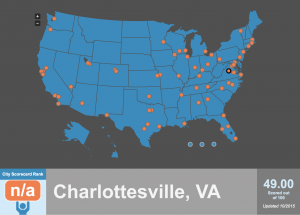 Charlottesville also self-scored and earned 49.00 out of 100 points. Of the Virginia locations scored, Charlottesville earned the most points for energy and utilities with a funded partnership with, another VAEEC member, the Local Energy Alliance Program (LEAP) and rebates for water conservation initiatives. Charlottesville also has green building requirements for municipal buildings and works through LEAP to fund the limited time 0% Power Saving Loan Program as part of its initiatives for efficient buildings. Charlottesville’s community-wide initiatives and local government operations are where improvements can be made most.
Charlottesville also self-scored and earned 49.00 out of 100 points. Of the Virginia locations scored, Charlottesville earned the most points for energy and utilities with a funded partnership with, another VAEEC member, the Local Energy Alliance Program (LEAP) and rebates for water conservation initiatives. Charlottesville also has green building requirements for municipal buildings and works through LEAP to fund the limited time 0% Power Saving Loan Program as part of its initiatives for efficient buildings. Charlottesville’s community-wide initiatives and local government operations are where improvements can be made most.
To see the full breakdown of scores for each city visit the ACEEE’s website.
Don’t see your town on the City Scorecard? Click here to try the updated Local Energy Efficiency Self-Scoring Tool, and see how your community stacks up! The Self-Scoring Tool is based off the 2015 City Scorecard.
 Give yourselves a pat on the back for Virginia earning the title of “Most Improved” in ACEEE’s 2017 State Energy Efficiency Scorecard.
Give yourselves a pat on the back for Virginia earning the title of “Most Improved” in ACEEE’s 2017 State Energy Efficiency Scorecard.

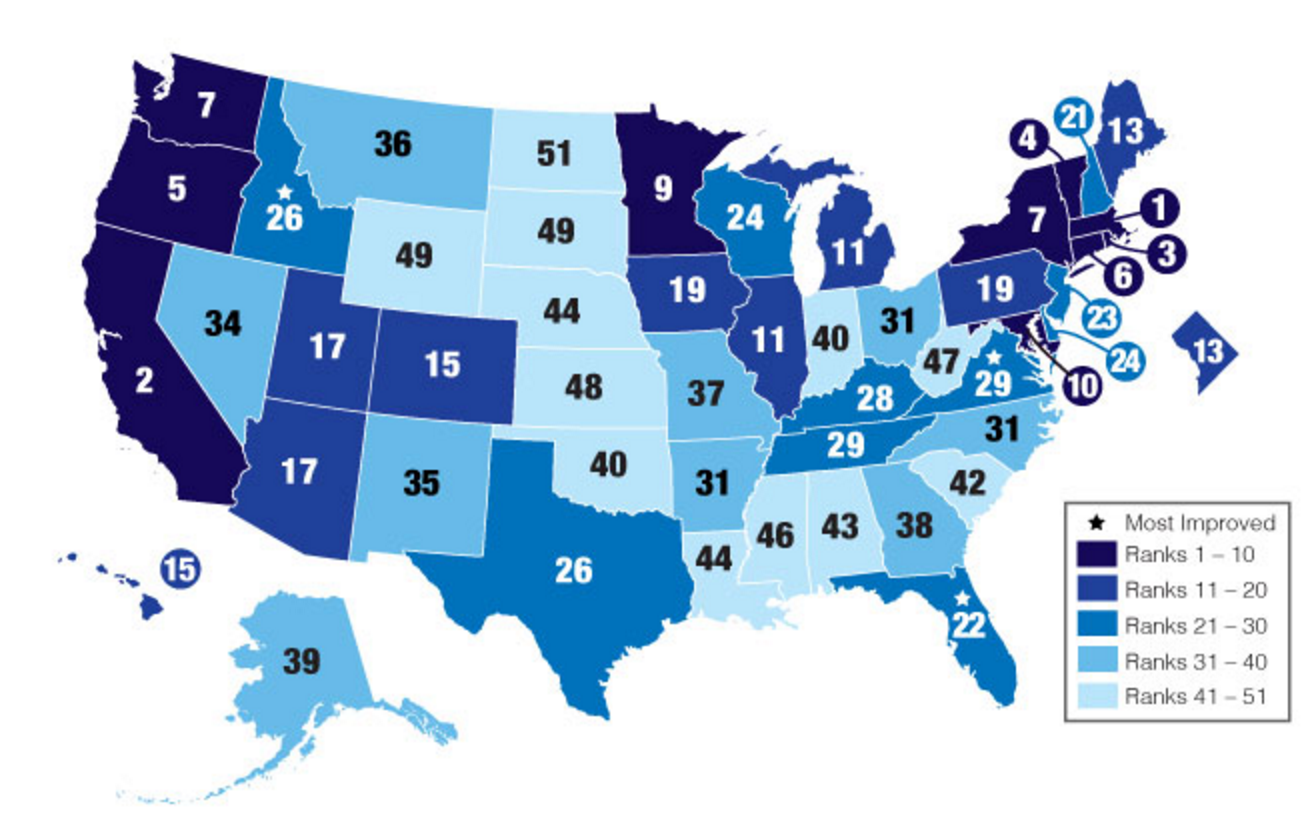
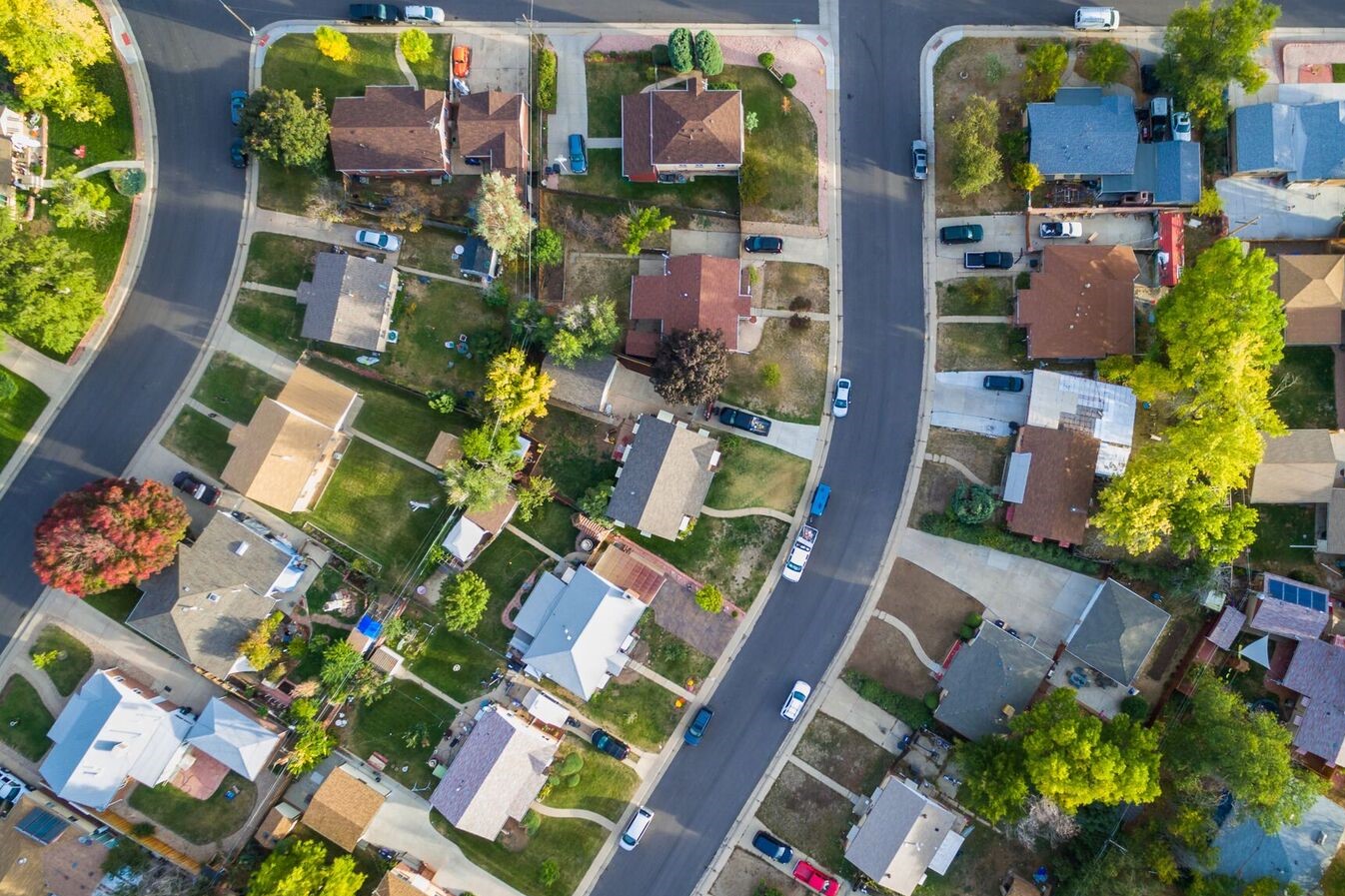
 A second component of the energy subgroup compromise proposal, includes adoption of the 2018 model code Energy Rating Index (ERI) compliance option rather than the 2015 version. This newer version gives homebuilders greater flexibility and trade-off options, which is important since homebuilders in states that have already adopted the 2015 model code, have been slow to use this pathway. By implementing the 2018 version, Virginia is making the ERI pathway more enticing, which will hopefully result in greater participation.
A second component of the energy subgroup compromise proposal, includes adoption of the 2018 model code Energy Rating Index (ERI) compliance option rather than the 2015 version. This newer version gives homebuilders greater flexibility and trade-off options, which is important since homebuilders in states that have already adopted the 2015 model code, have been slow to use this pathway. By implementing the 2018 version, Virginia is making the ERI pathway more enticing, which will hopefully result in greater participation. VAEEC partnered with one of our members, Responsible Energy Codes Alliance, to submit a proposal to DHCD staff to host a stakeholder group to review these issues next year, in the hopes that a compromise can be reached on inclusion of this crucial energy efficiency practice in the next USBC update. Last month, we were pleased to see the full DHCD board unanimously vote to support these efforts.
VAEEC partnered with one of our members, Responsible Energy Codes Alliance, to submit a proposal to DHCD staff to host a stakeholder group to review these issues next year, in the hopes that a compromise can be reached on inclusion of this crucial energy efficiency practice in the next USBC update. Last month, we were pleased to see the full DHCD board unanimously vote to support these efforts.

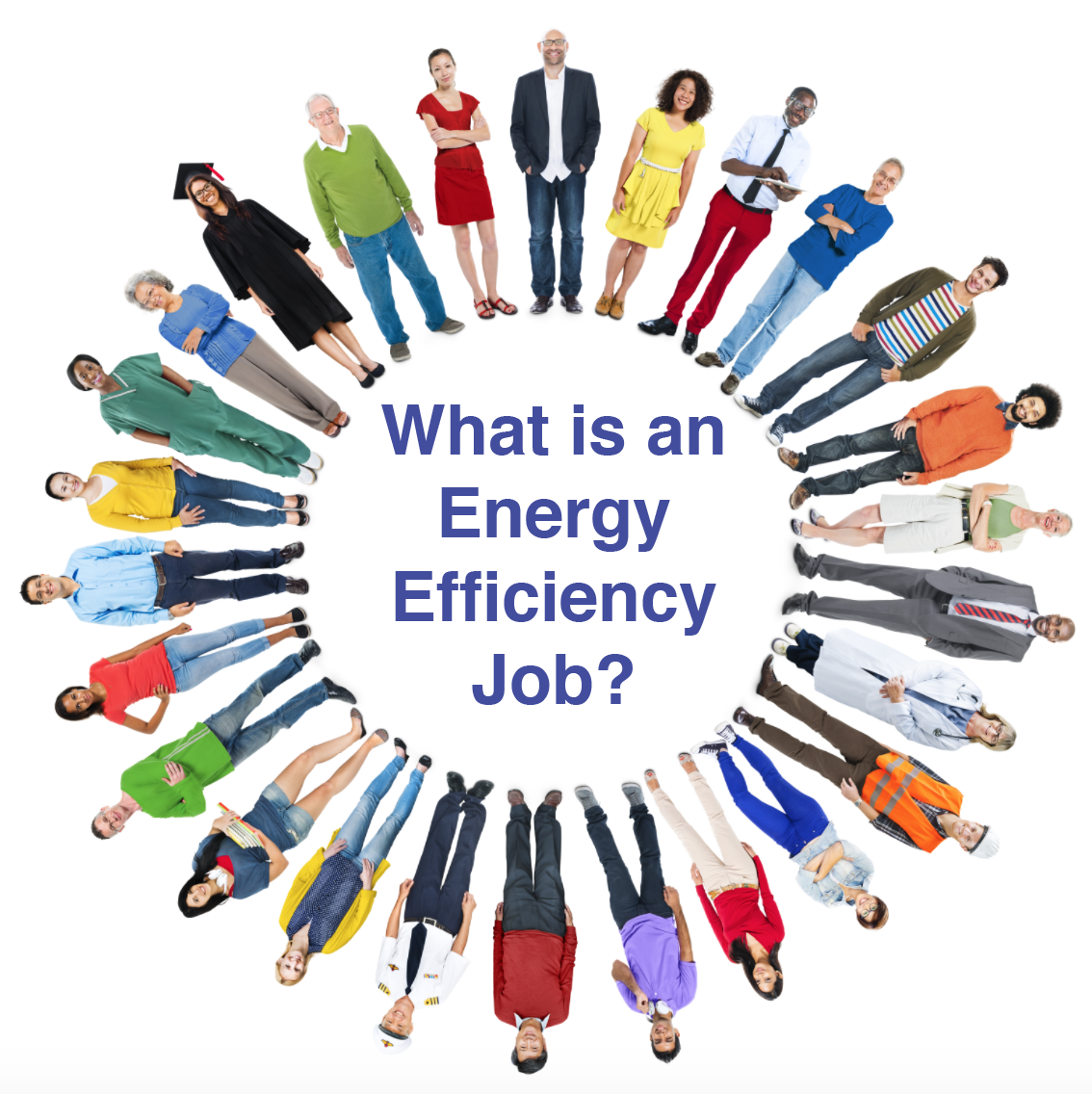





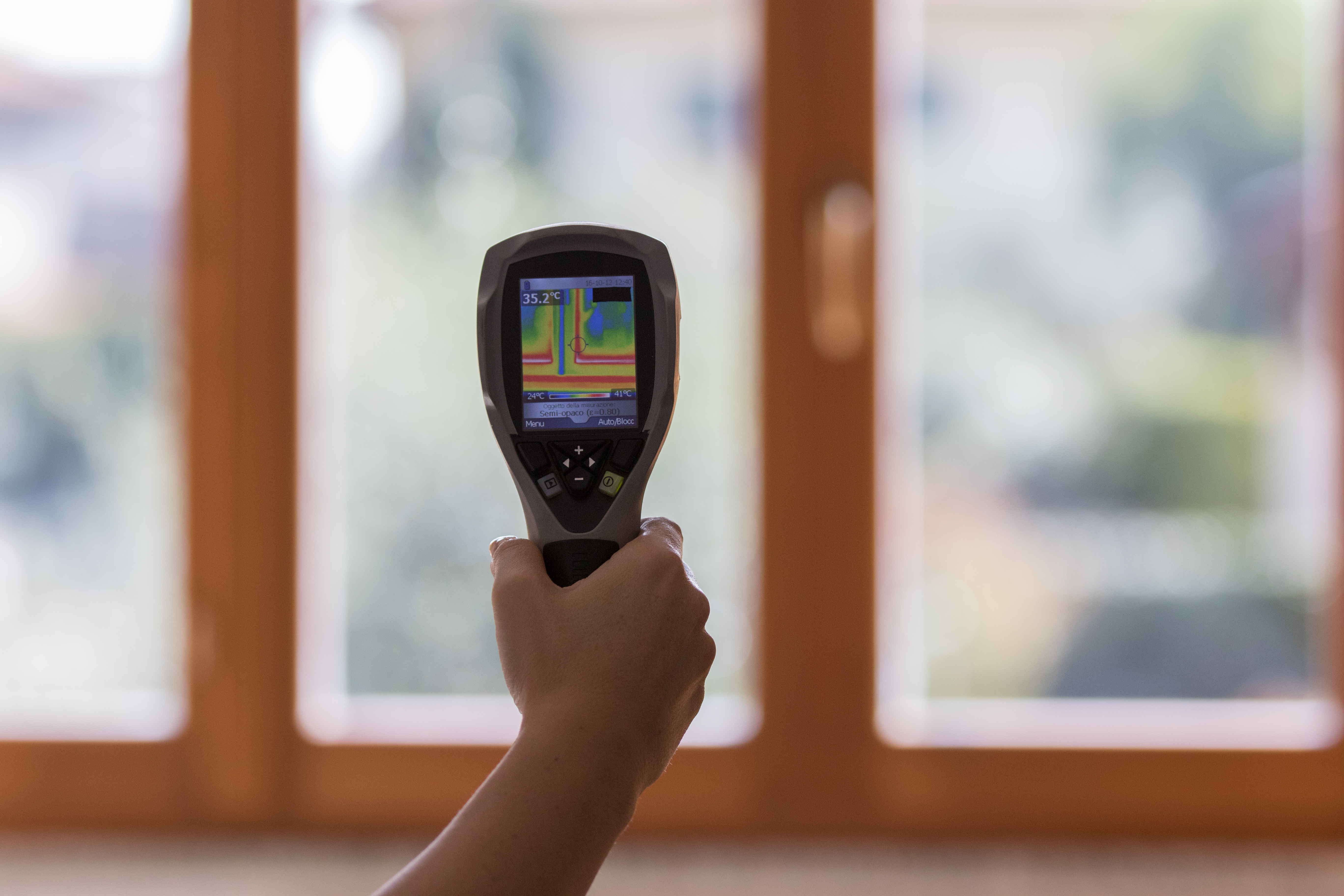




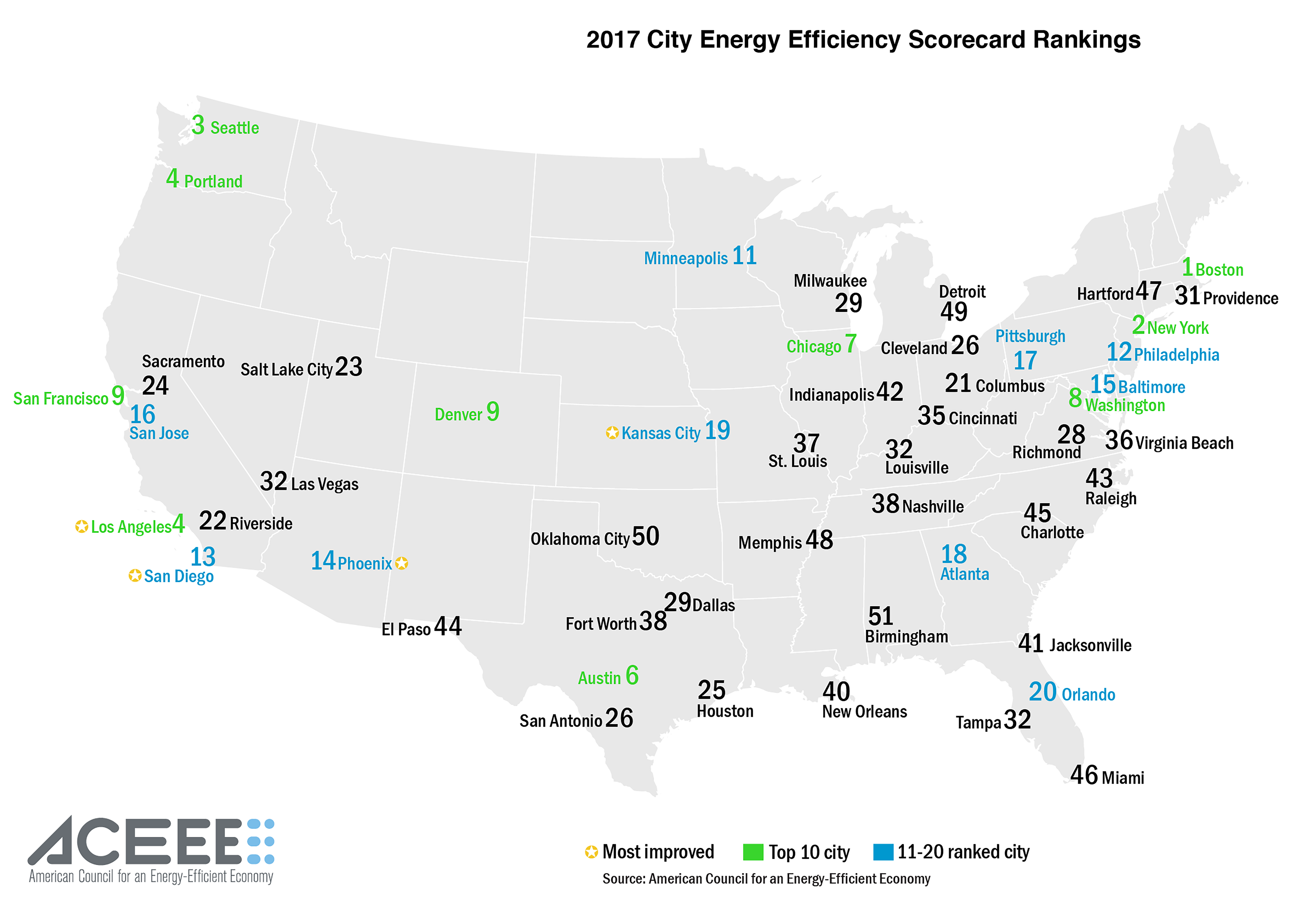




 Charlottesville also self-scored and earned 49.00 out of 100 points. Of the Virginia locations scored, Charlottesville earned the most points for energy and utilities with a funded partnership with, another VAEEC member, the Local Energy Alliance Program (LEAP) and rebates for water conservation initiatives. Charlottesville also has green building requirements for municipal buildings and works through LEAP to fund the limited time 0% Power Saving Loan Program as part of its initiatives for efficient buildings. Charlottesville’s community-wide initiatives and local government operations are where improvements can be made most.
Charlottesville also self-scored and earned 49.00 out of 100 points. Of the Virginia locations scored, Charlottesville earned the most points for energy and utilities with a funded partnership with, another VAEEC member, the Local Energy Alliance Program (LEAP) and rebates for water conservation initiatives. Charlottesville also has green building requirements for municipal buildings and works through LEAP to fund the limited time 0% Power Saving Loan Program as part of its initiatives for efficient buildings. Charlottesville’s community-wide initiatives and local government operations are where improvements can be made most.